Contract Analysis: Shampoo Purchase Agreement
VerifiedAdded on 2020/01/07
|15
|5331
|164
Case Study
AI Summary
This assignment requires students to analyze a purchase agreement between two companies, Bella UK (the seller) and Hair 4 U (the buyer), regarding the sale of 'Miracle Oil' shampoo. Students must carefully examine the terms and conditions outlined in the agreement, including pricing, delivery, liability, product quality guarantees, and risk allocation.
Contribute Materials
Your contribution can guide someone’s learning journey. Share your
documents today.
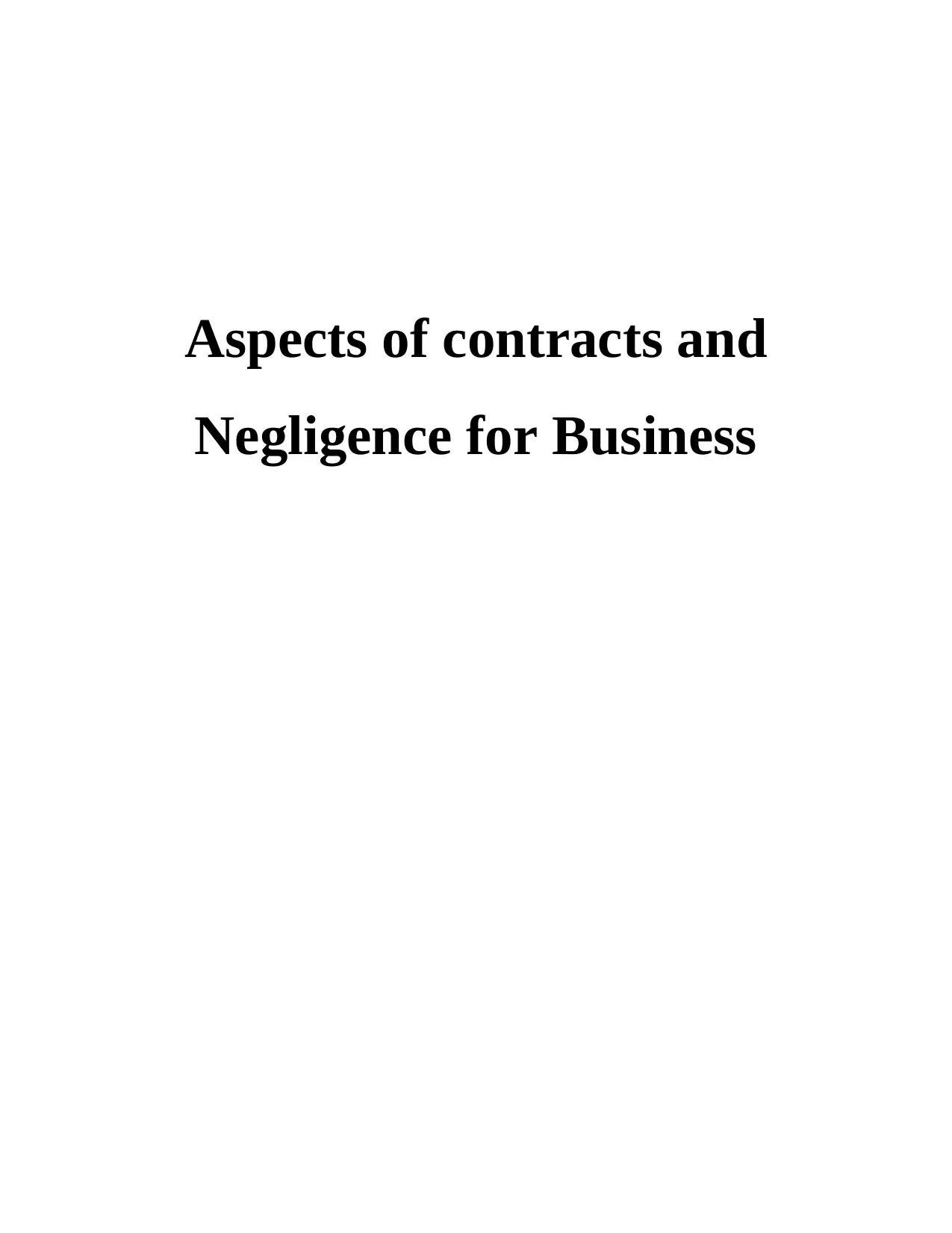
Aspects of contracts and
Negligence for Business
Negligence for Business
Secure Best Marks with AI Grader
Need help grading? Try our AI Grader for instant feedback on your assignments.
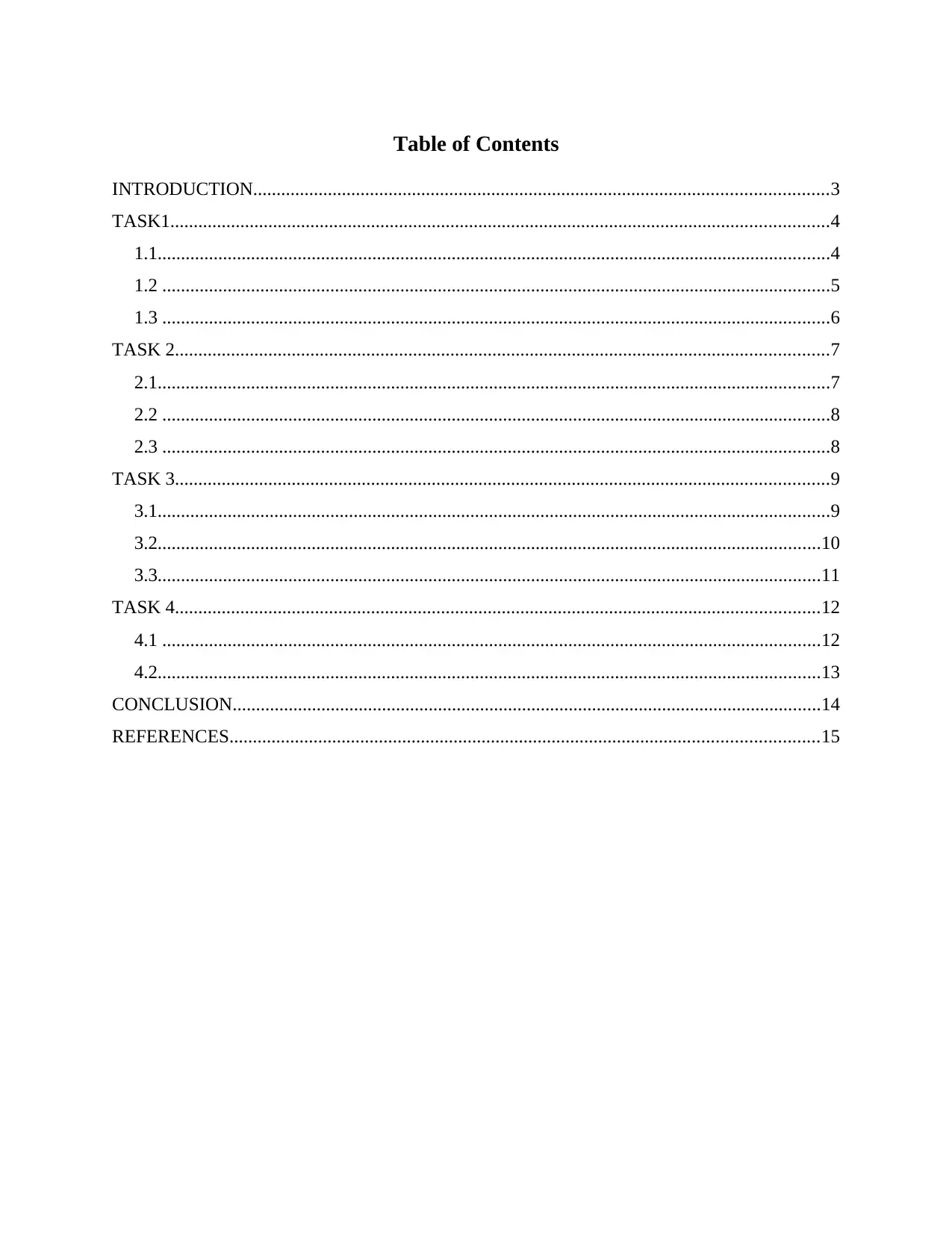
Table of Contents
INTRODUCTION...........................................................................................................................3
TASK1.............................................................................................................................................4
1.1................................................................................................................................................4
1.2 ...............................................................................................................................................5
1.3 ...............................................................................................................................................6
TASK 2............................................................................................................................................7
2.1................................................................................................................................................7
2.2 ...............................................................................................................................................8
2.3 ...............................................................................................................................................8
TASK 3............................................................................................................................................9
3.1................................................................................................................................................9
3.2..............................................................................................................................................10
3.3..............................................................................................................................................11
TASK 4..........................................................................................................................................12
4.1 .............................................................................................................................................12
4.2..............................................................................................................................................13
CONCLUSION..............................................................................................................................14
REFERENCES..............................................................................................................................15
INTRODUCTION...........................................................................................................................3
TASK1.............................................................................................................................................4
1.1................................................................................................................................................4
1.2 ...............................................................................................................................................5
1.3 ...............................................................................................................................................6
TASK 2............................................................................................................................................7
2.1................................................................................................................................................7
2.2 ...............................................................................................................................................8
2.3 ...............................................................................................................................................8
TASK 3............................................................................................................................................9
3.1................................................................................................................................................9
3.2..............................................................................................................................................10
3.3..............................................................................................................................................11
TASK 4..........................................................................................................................................12
4.1 .............................................................................................................................................12
4.2..............................................................................................................................................13
CONCLUSION..............................................................................................................................14
REFERENCES..............................................................................................................................15
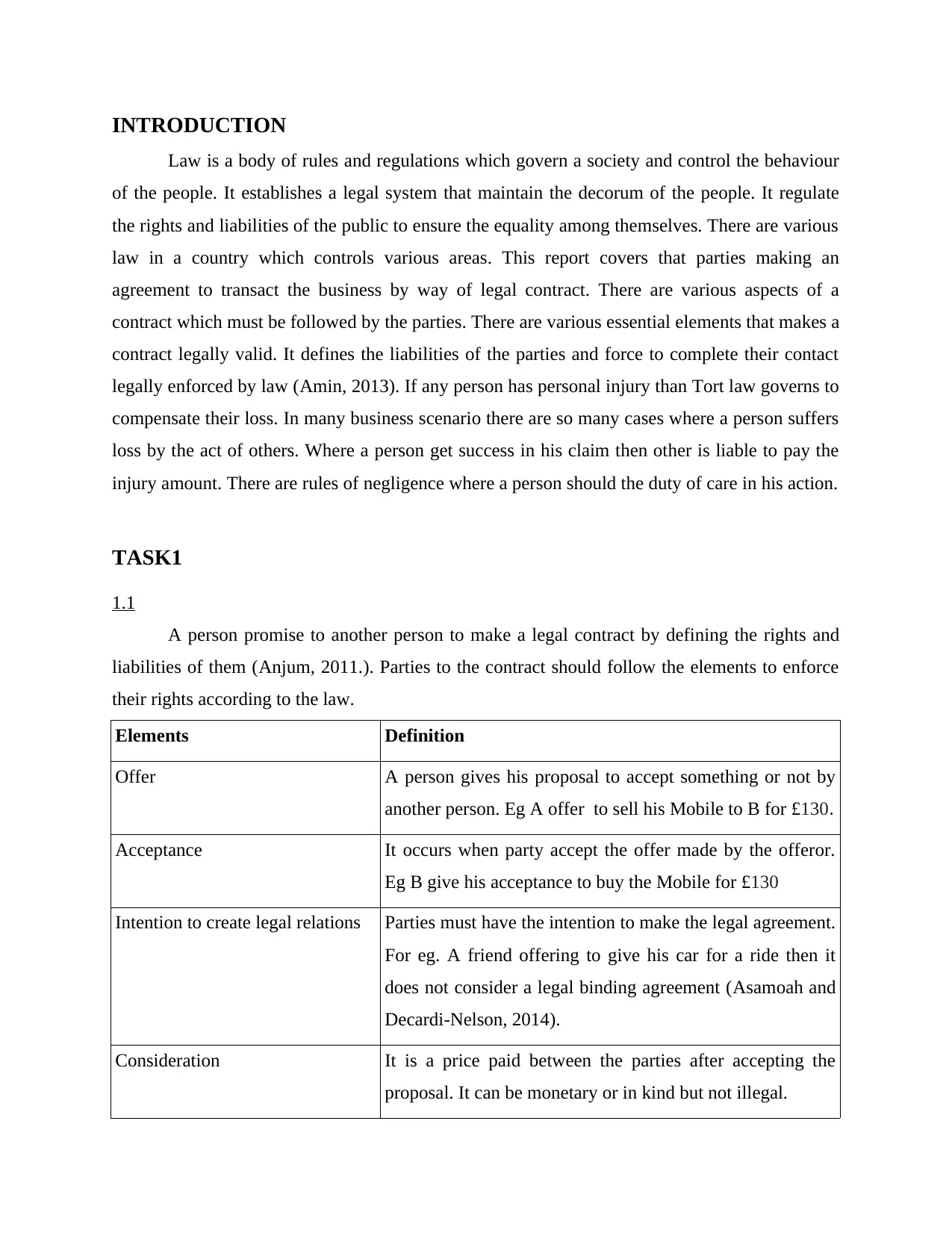
INTRODUCTION
Law is a body of rules and regulations which govern a society and control the behaviour
of the people. It establishes a legal system that maintain the decorum of the people. It regulate
the rights and liabilities of the public to ensure the equality among themselves. There are various
law in a country which controls various areas. This report covers that parties making an
agreement to transact the business by way of legal contract. There are various aspects of a
contract which must be followed by the parties. There are various essential elements that makes a
contract legally valid. It defines the liabilities of the parties and force to complete their contact
legally enforced by law (Amin, 2013). If any person has personal injury than Tort law governs to
compensate their loss. In many business scenario there are so many cases where a person suffers
loss by the act of others. Where a person get success in his claim then other is liable to pay the
injury amount. There are rules of negligence where a person should the duty of care in his action.
TASK1
1.1
A person promise to another person to make a legal contract by defining the rights and
liabilities of them (Anjum, 2011.). Parties to the contract should follow the elements to enforce
their rights according to the law.
Elements Definition
Offer A person gives his proposal to accept something or not by
another person. Eg A offer to sell his Mobile to B for £130.
Acceptance It occurs when party accept the offer made by the offeror.
Eg B give his acceptance to buy the Mobile for £130
Intention to create legal relations Parties must have the intention to make the legal agreement.
For eg. A friend offering to give his car for a ride then it
does not consider a legal binding agreement (Asamoah and
Decardi-Nelson, 2014).
Consideration It is a price paid between the parties after accepting the
proposal. It can be monetary or in kind but not illegal.
Law is a body of rules and regulations which govern a society and control the behaviour
of the people. It establishes a legal system that maintain the decorum of the people. It regulate
the rights and liabilities of the public to ensure the equality among themselves. There are various
law in a country which controls various areas. This report covers that parties making an
agreement to transact the business by way of legal contract. There are various aspects of a
contract which must be followed by the parties. There are various essential elements that makes a
contract legally valid. It defines the liabilities of the parties and force to complete their contact
legally enforced by law (Amin, 2013). If any person has personal injury than Tort law governs to
compensate their loss. In many business scenario there are so many cases where a person suffers
loss by the act of others. Where a person get success in his claim then other is liable to pay the
injury amount. There are rules of negligence where a person should the duty of care in his action.
TASK1
1.1
A person promise to another person to make a legal contract by defining the rights and
liabilities of them (Anjum, 2011.). Parties to the contract should follow the elements to enforce
their rights according to the law.
Elements Definition
Offer A person gives his proposal to accept something or not by
another person. Eg A offer to sell his Mobile to B for £130.
Acceptance It occurs when party accept the offer made by the offeror.
Eg B give his acceptance to buy the Mobile for £130
Intention to create legal relations Parties must have the intention to make the legal agreement.
For eg. A friend offering to give his car for a ride then it
does not consider a legal binding agreement (Asamoah and
Decardi-Nelson, 2014).
Consideration It is a price paid between the parties after accepting the
proposal. It can be monetary or in kind but not illegal.
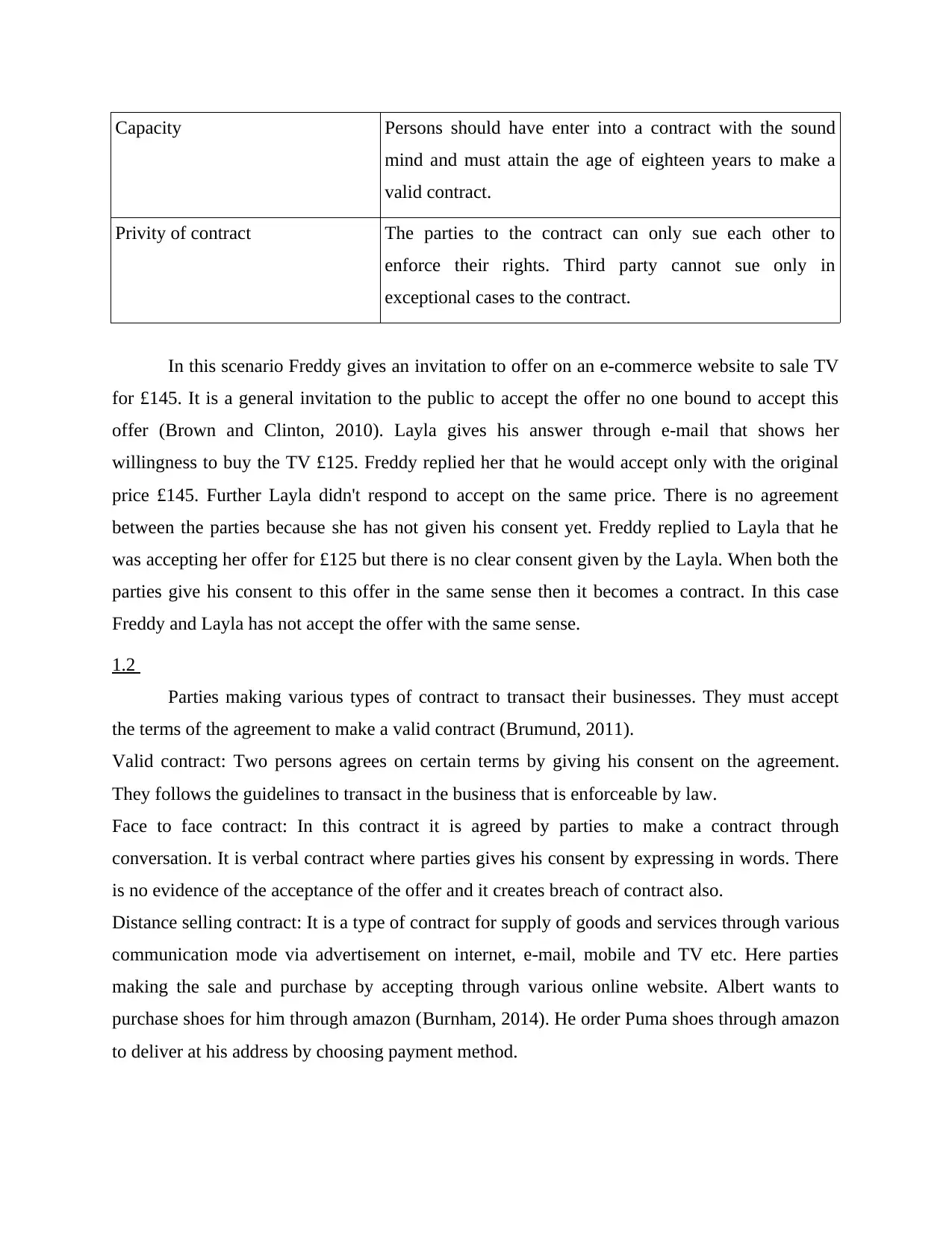
Capacity Persons should have enter into a contract with the sound
mind and must attain the age of eighteen years to make a
valid contract.
Privity of contract The parties to the contract can only sue each other to
enforce their rights. Third party cannot sue only in
exceptional cases to the contract.
In this scenario Freddy gives an invitation to offer on an e-commerce website to sale TV
for £145. It is a general invitation to the public to accept the offer no one bound to accept this
offer (Brown and Clinton, 2010). Layla gives his answer through e-mail that shows her
willingness to buy the TV £125. Freddy replied her that he would accept only with the original
price £145. Further Layla didn't respond to accept on the same price. There is no agreement
between the parties because she has not given his consent yet. Freddy replied to Layla that he
was accepting her offer for £125 but there is no clear consent given by the Layla. When both the
parties give his consent to this offer in the same sense then it becomes a contract. In this case
Freddy and Layla has not accept the offer with the same sense.
1.2
Parties making various types of contract to transact their businesses. They must accept
the terms of the agreement to make a valid contract (Brumund, 2011).
Valid contract: Two persons agrees on certain terms by giving his consent on the agreement.
They follows the guidelines to transact in the business that is enforceable by law.
Face to face contract: In this contract it is agreed by parties to make a contract through
conversation. It is verbal contract where parties gives his consent by expressing in words. There
is no evidence of the acceptance of the offer and it creates breach of contract also.
Distance selling contract: It is a type of contract for supply of goods and services through various
communication mode via advertisement on internet, e-mail, mobile and TV etc. Here parties
making the sale and purchase by accepting through various online website. Albert wants to
purchase shoes for him through amazon (Burnham, 2014). He order Puma shoes through amazon
to deliver at his address by choosing payment method.
mind and must attain the age of eighteen years to make a
valid contract.
Privity of contract The parties to the contract can only sue each other to
enforce their rights. Third party cannot sue only in
exceptional cases to the contract.
In this scenario Freddy gives an invitation to offer on an e-commerce website to sale TV
for £145. It is a general invitation to the public to accept the offer no one bound to accept this
offer (Brown and Clinton, 2010). Layla gives his answer through e-mail that shows her
willingness to buy the TV £125. Freddy replied her that he would accept only with the original
price £145. Further Layla didn't respond to accept on the same price. There is no agreement
between the parties because she has not given his consent yet. Freddy replied to Layla that he
was accepting her offer for £125 but there is no clear consent given by the Layla. When both the
parties give his consent to this offer in the same sense then it becomes a contract. In this case
Freddy and Layla has not accept the offer with the same sense.
1.2
Parties making various types of contract to transact their businesses. They must accept
the terms of the agreement to make a valid contract (Brumund, 2011).
Valid contract: Two persons agrees on certain terms by giving his consent on the agreement.
They follows the guidelines to transact in the business that is enforceable by law.
Face to face contract: In this contract it is agreed by parties to make a contract through
conversation. It is verbal contract where parties gives his consent by expressing in words. There
is no evidence of the acceptance of the offer and it creates breach of contract also.
Distance selling contract: It is a type of contract for supply of goods and services through various
communication mode via advertisement on internet, e-mail, mobile and TV etc. Here parties
making the sale and purchase by accepting through various online website. Albert wants to
purchase shoes for him through amazon (Burnham, 2014). He order Puma shoes through amazon
to deliver at his address by choosing payment method.
Secure Best Marks with AI Grader
Need help grading? Try our AI Grader for instant feedback on your assignments.
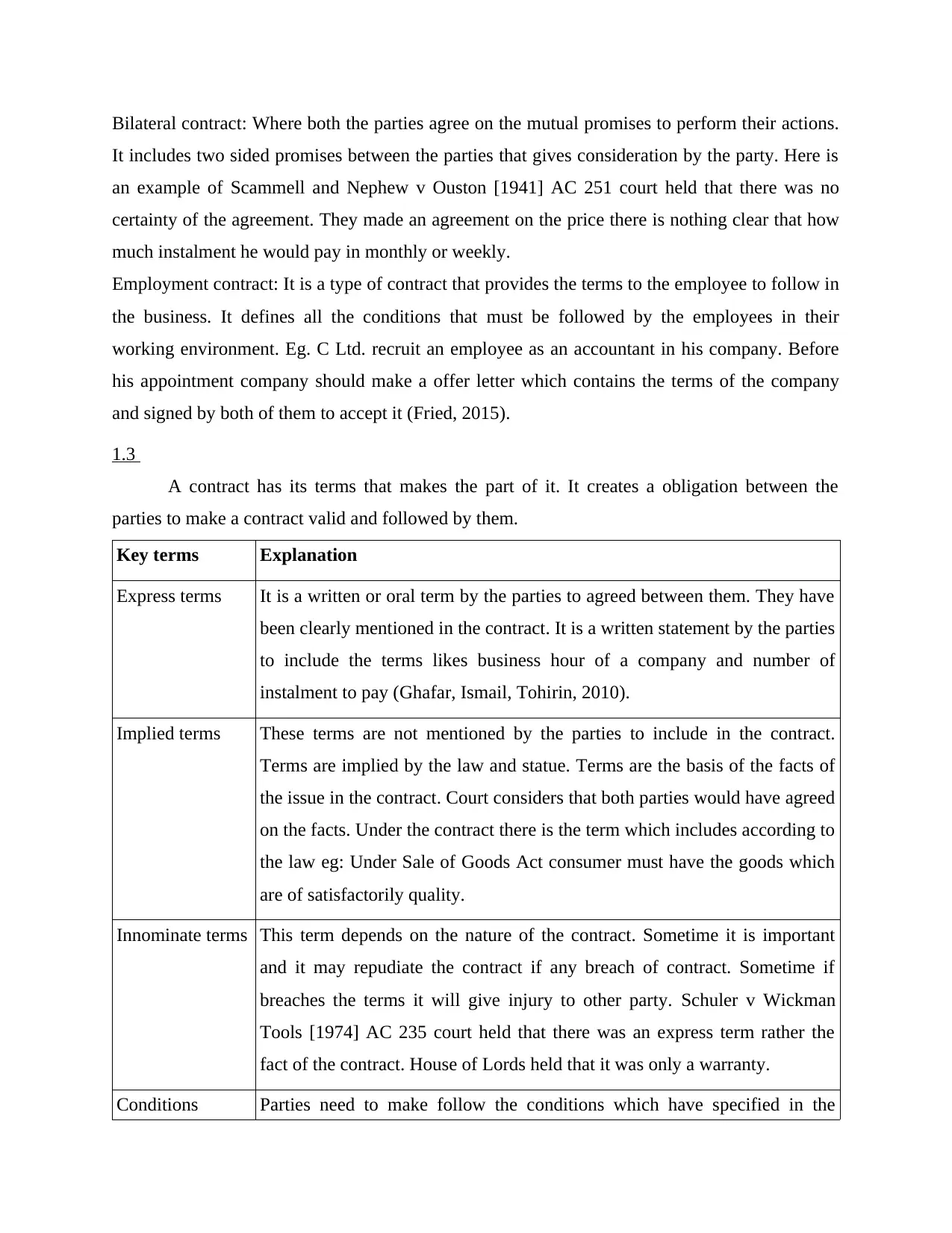
Bilateral contract: Where both the parties agree on the mutual promises to perform their actions.
It includes two sided promises between the parties that gives consideration by the party. Here is
an example of Scammell and Nephew v Ouston [1941] AC 251 court held that there was no
certainty of the agreement. They made an agreement on the price there is nothing clear that how
much instalment he would pay in monthly or weekly.
Employment contract: It is a type of contract that provides the terms to the employee to follow in
the business. It defines all the conditions that must be followed by the employees in their
working environment. Eg. C Ltd. recruit an employee as an accountant in his company. Before
his appointment company should make a offer letter which contains the terms of the company
and signed by both of them to accept it (Fried, 2015).
1.3
A contract has its terms that makes the part of it. It creates a obligation between the
parties to make a contract valid and followed by them.
Key terms Explanation
Express terms It is a written or oral term by the parties to agreed between them. They have
been clearly mentioned in the contract. It is a written statement by the parties
to include the terms likes business hour of a company and number of
instalment to pay (Ghafar, Ismail, Tohirin, 2010).
Implied terms These terms are not mentioned by the parties to include in the contract.
Terms are implied by the law and statue. Terms are the basis of the facts of
the issue in the contract. Court considers that both parties would have agreed
on the facts. Under the contract there is the term which includes according to
the law eg: Under Sale of Goods Act consumer must have the goods which
are of satisfactorily quality.
Innominate terms This term depends on the nature of the contract. Sometime it is important
and it may repudiate the contract if any breach of contract. Sometime if
breaches the terms it will give injury to other party. Schuler v Wickman
Tools [1974] AC 235 court held that there was an express term rather the
fact of the contract. House of Lords held that it was only a warranty.
Conditions Parties need to make follow the conditions which have specified in the
It includes two sided promises between the parties that gives consideration by the party. Here is
an example of Scammell and Nephew v Ouston [1941] AC 251 court held that there was no
certainty of the agreement. They made an agreement on the price there is nothing clear that how
much instalment he would pay in monthly or weekly.
Employment contract: It is a type of contract that provides the terms to the employee to follow in
the business. It defines all the conditions that must be followed by the employees in their
working environment. Eg. C Ltd. recruit an employee as an accountant in his company. Before
his appointment company should make a offer letter which contains the terms of the company
and signed by both of them to accept it (Fried, 2015).
1.3
A contract has its terms that makes the part of it. It creates a obligation between the
parties to make a contract valid and followed by them.
Key terms Explanation
Express terms It is a written or oral term by the parties to agreed between them. They have
been clearly mentioned in the contract. It is a written statement by the parties
to include the terms likes business hour of a company and number of
instalment to pay (Ghafar, Ismail, Tohirin, 2010).
Implied terms These terms are not mentioned by the parties to include in the contract.
Terms are implied by the law and statue. Terms are the basis of the facts of
the issue in the contract. Court considers that both parties would have agreed
on the facts. Under the contract there is the term which includes according to
the law eg: Under Sale of Goods Act consumer must have the goods which
are of satisfactorily quality.
Innominate terms This term depends on the nature of the contract. Sometime it is important
and it may repudiate the contract if any breach of contract. Sometime if
breaches the terms it will give injury to other party. Schuler v Wickman
Tools [1974] AC 235 court held that there was an express term rather the
fact of the contract. House of Lords held that it was only a warranty.
Conditions Parties need to make follow the conditions which have specified in the
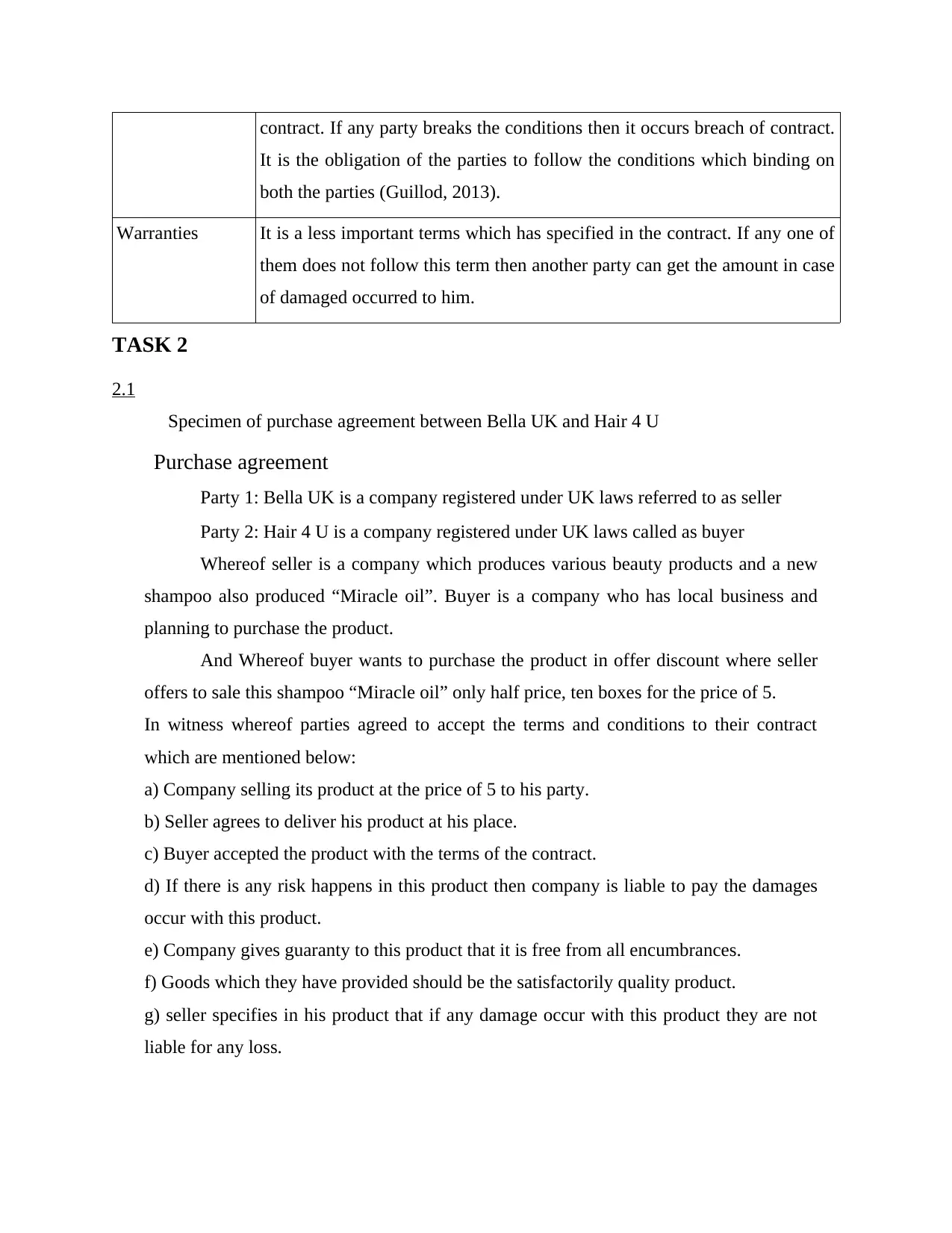
contract. If any party breaks the conditions then it occurs breach of contract.
It is the obligation of the parties to follow the conditions which binding on
both the parties (Guillod, 2013).
Warranties It is a less important terms which has specified in the contract. If any one of
them does not follow this term then another party can get the amount in case
of damaged occurred to him.
TASK 2
2.1
Specimen of purchase agreement between Bella UK and Hair 4 U
Purchase agreement
Party 1: Bella UK is a company registered under UK laws referred to as seller
Party 2: Hair 4 U is a company registered under UK laws called as buyer
Whereof seller is a company which produces various beauty products and a new
shampoo also produced “Miracle oil”. Buyer is a company who has local business and
planning to purchase the product.
And Whereof buyer wants to purchase the product in offer discount where seller
offers to sale this shampoo “Miracle oil” only half price, ten boxes for the price of 5.
In witness whereof parties agreed to accept the terms and conditions to their contract
which are mentioned below:
a) Company selling its product at the price of 5 to his party.
b) Seller agrees to deliver his product at his place.
c) Buyer accepted the product with the terms of the contract.
d) If there is any risk happens in this product then company is liable to pay the damages
occur with this product.
e) Company gives guaranty to this product that it is free from all encumbrances.
f) Goods which they have provided should be the satisfactorily quality product.
g) seller specifies in his product that if any damage occur with this product they are not
liable for any loss.
It is the obligation of the parties to follow the conditions which binding on
both the parties (Guillod, 2013).
Warranties It is a less important terms which has specified in the contract. If any one of
them does not follow this term then another party can get the amount in case
of damaged occurred to him.
TASK 2
2.1
Specimen of purchase agreement between Bella UK and Hair 4 U
Purchase agreement
Party 1: Bella UK is a company registered under UK laws referred to as seller
Party 2: Hair 4 U is a company registered under UK laws called as buyer
Whereof seller is a company which produces various beauty products and a new
shampoo also produced “Miracle oil”. Buyer is a company who has local business and
planning to purchase the product.
And Whereof buyer wants to purchase the product in offer discount where seller
offers to sale this shampoo “Miracle oil” only half price, ten boxes for the price of 5.
In witness whereof parties agreed to accept the terms and conditions to their contract
which are mentioned below:
a) Company selling its product at the price of 5 to his party.
b) Seller agrees to deliver his product at his place.
c) Buyer accepted the product with the terms of the contract.
d) If there is any risk happens in this product then company is liable to pay the damages
occur with this product.
e) Company gives guaranty to this product that it is free from all encumbrances.
f) Goods which they have provided should be the satisfactorily quality product.
g) seller specifies in his product that if any damage occur with this product they are not
liable for any loss.
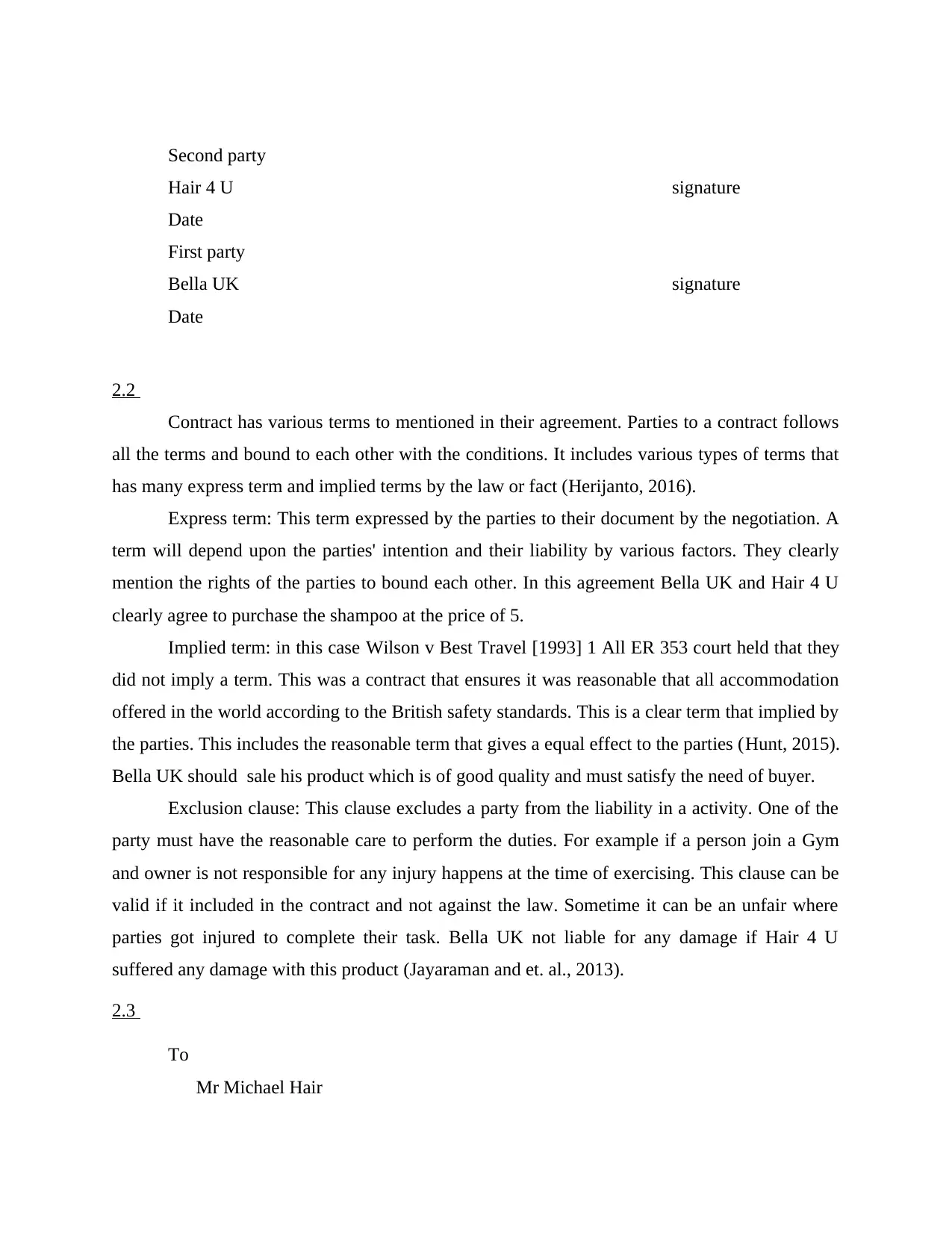
Second party
Hair 4 U signature
Date
First party
Bella UK signature
Date
2.2
Contract has various terms to mentioned in their agreement. Parties to a contract follows
all the terms and bound to each other with the conditions. It includes various types of terms that
has many express term and implied terms by the law or fact (Herijanto, 2016).
Express term: This term expressed by the parties to their document by the negotiation. A
term will depend upon the parties' intention and their liability by various factors. They clearly
mention the rights of the parties to bound each other. In this agreement Bella UK and Hair 4 U
clearly agree to purchase the shampoo at the price of 5.
Implied term: in this case Wilson v Best Travel [1993] 1 All ER 353 court held that they
did not imply a term. This was a contract that ensures it was reasonable that all accommodation
offered in the world according to the British safety standards. This is a clear term that implied by
the parties. This includes the reasonable term that gives a equal effect to the parties (Hunt, 2015).
Bella UK should sale his product which is of good quality and must satisfy the need of buyer.
Exclusion clause: This clause excludes a party from the liability in a activity. One of the
party must have the reasonable care to perform the duties. For example if a person join a Gym
and owner is not responsible for any injury happens at the time of exercising. This clause can be
valid if it included in the contract and not against the law. Sometime it can be an unfair where
parties got injured to complete their task. Bella UK not liable for any damage if Hair 4 U
suffered any damage with this product (Jayaraman and et. al., 2013).
2.3
To
Mr Michael Hair
Hair 4 U signature
Date
First party
Bella UK signature
Date
2.2
Contract has various terms to mentioned in their agreement. Parties to a contract follows
all the terms and bound to each other with the conditions. It includes various types of terms that
has many express term and implied terms by the law or fact (Herijanto, 2016).
Express term: This term expressed by the parties to their document by the negotiation. A
term will depend upon the parties' intention and their liability by various factors. They clearly
mention the rights of the parties to bound each other. In this agreement Bella UK and Hair 4 U
clearly agree to purchase the shampoo at the price of 5.
Implied term: in this case Wilson v Best Travel [1993] 1 All ER 353 court held that they
did not imply a term. This was a contract that ensures it was reasonable that all accommodation
offered in the world according to the British safety standards. This is a clear term that implied by
the parties. This includes the reasonable term that gives a equal effect to the parties (Hunt, 2015).
Bella UK should sale his product which is of good quality and must satisfy the need of buyer.
Exclusion clause: This clause excludes a party from the liability in a activity. One of the
party must have the reasonable care to perform the duties. For example if a person join a Gym
and owner is not responsible for any injury happens at the time of exercising. This clause can be
valid if it included in the contract and not against the law. Sometime it can be an unfair where
parties got injured to complete their task. Bella UK not liable for any damage if Hair 4 U
suffered any damage with this product (Jayaraman and et. al., 2013).
2.3
To
Mr Michael Hair
Paraphrase This Document
Need a fresh take? Get an instant paraphrase of this document with our AI Paraphraser
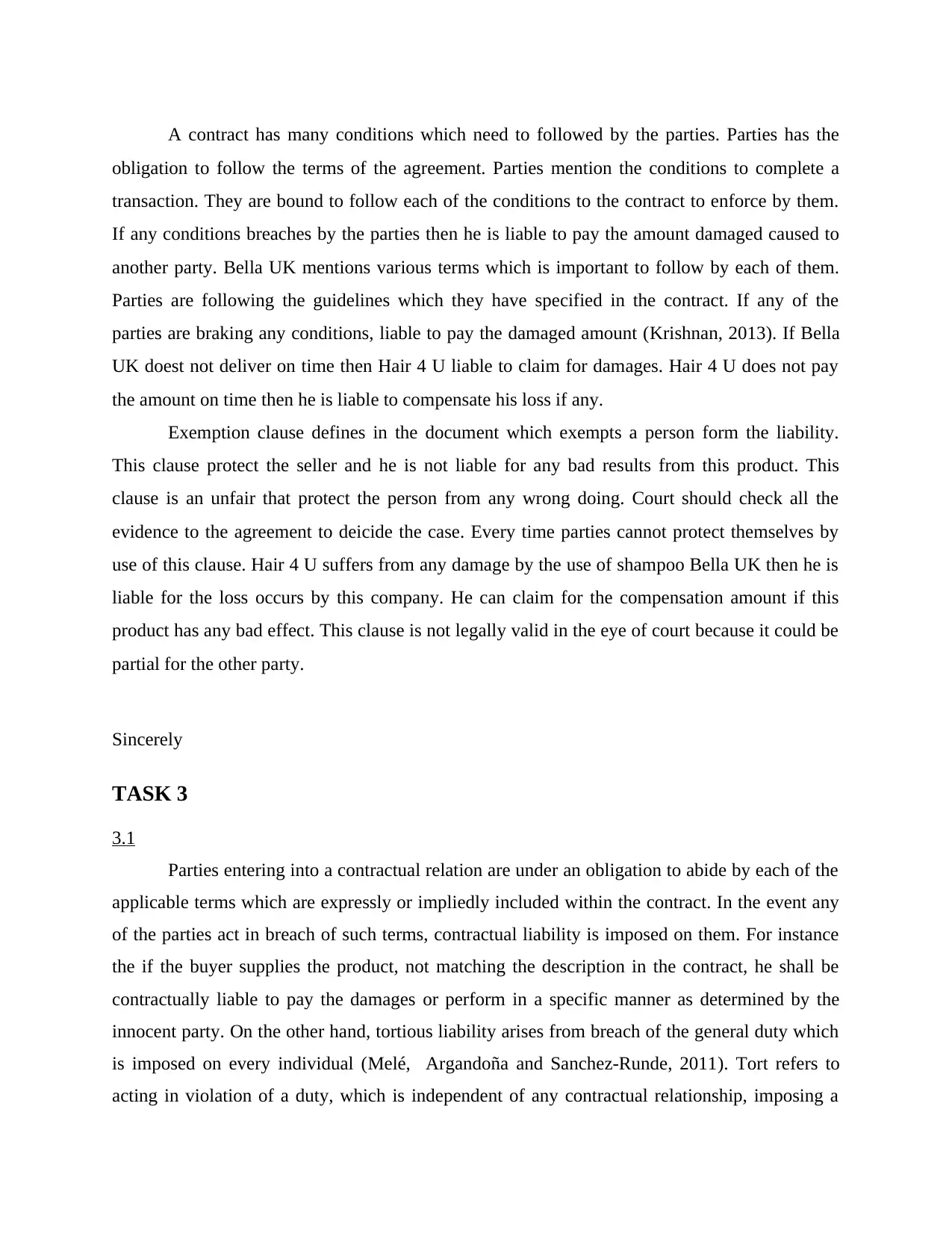
A contract has many conditions which need to followed by the parties. Parties has the
obligation to follow the terms of the agreement. Parties mention the conditions to complete a
transaction. They are bound to follow each of the conditions to the contract to enforce by them.
If any conditions breaches by the parties then he is liable to pay the amount damaged caused to
another party. Bella UK mentions various terms which is important to follow by each of them.
Parties are following the guidelines which they have specified in the contract. If any of the
parties are braking any conditions, liable to pay the damaged amount (Krishnan, 2013). If Bella
UK doest not deliver on time then Hair 4 U liable to claim for damages. Hair 4 U does not pay
the amount on time then he is liable to compensate his loss if any.
Exemption clause defines in the document which exempts a person form the liability.
This clause protect the seller and he is not liable for any bad results from this product. This
clause is an unfair that protect the person from any wrong doing. Court should check all the
evidence to the agreement to deicide the case. Every time parties cannot protect themselves by
use of this clause. Hair 4 U suffers from any damage by the use of shampoo Bella UK then he is
liable for the loss occurs by this company. He can claim for the compensation amount if this
product has any bad effect. This clause is not legally valid in the eye of court because it could be
partial for the other party.
Sincerely
TASK 3
3.1
Parties entering into a contractual relation are under an obligation to abide by each of the
applicable terms which are expressly or impliedly included within the contract. In the event any
of the parties act in breach of such terms, contractual liability is imposed on them. For instance
the if the buyer supplies the product, not matching the description in the contract, he shall be
contractually liable to pay the damages or perform in a specific manner as determined by the
innocent party. On the other hand, tortious liability arises from breach of the general duty which
is imposed on every individual (Melé, Argandoña and Sanchez-Runde, 2011). Tort refers to
acting in violation of a duty, which is independent of any contractual relationship, imposing a
obligation to follow the terms of the agreement. Parties mention the conditions to complete a
transaction. They are bound to follow each of the conditions to the contract to enforce by them.
If any conditions breaches by the parties then he is liable to pay the amount damaged caused to
another party. Bella UK mentions various terms which is important to follow by each of them.
Parties are following the guidelines which they have specified in the contract. If any of the
parties are braking any conditions, liable to pay the damaged amount (Krishnan, 2013). If Bella
UK doest not deliver on time then Hair 4 U liable to claim for damages. Hair 4 U does not pay
the amount on time then he is liable to compensate his loss if any.
Exemption clause defines in the document which exempts a person form the liability.
This clause protect the seller and he is not liable for any bad results from this product. This
clause is an unfair that protect the person from any wrong doing. Court should check all the
evidence to the agreement to deicide the case. Every time parties cannot protect themselves by
use of this clause. Hair 4 U suffers from any damage by the use of shampoo Bella UK then he is
liable for the loss occurs by this company. He can claim for the compensation amount if this
product has any bad effect. This clause is not legally valid in the eye of court because it could be
partial for the other party.
Sincerely
TASK 3
3.1
Parties entering into a contractual relation are under an obligation to abide by each of the
applicable terms which are expressly or impliedly included within the contract. In the event any
of the parties act in breach of such terms, contractual liability is imposed on them. For instance
the if the buyer supplies the product, not matching the description in the contract, he shall be
contractually liable to pay the damages or perform in a specific manner as determined by the
innocent party. On the other hand, tortious liability arises from breach of the general duty which
is imposed on every individual (Melé, Argandoña and Sanchez-Runde, 2011). Tort refers to
acting in violation of a duty, which is independent of any contractual relationship, imposing a
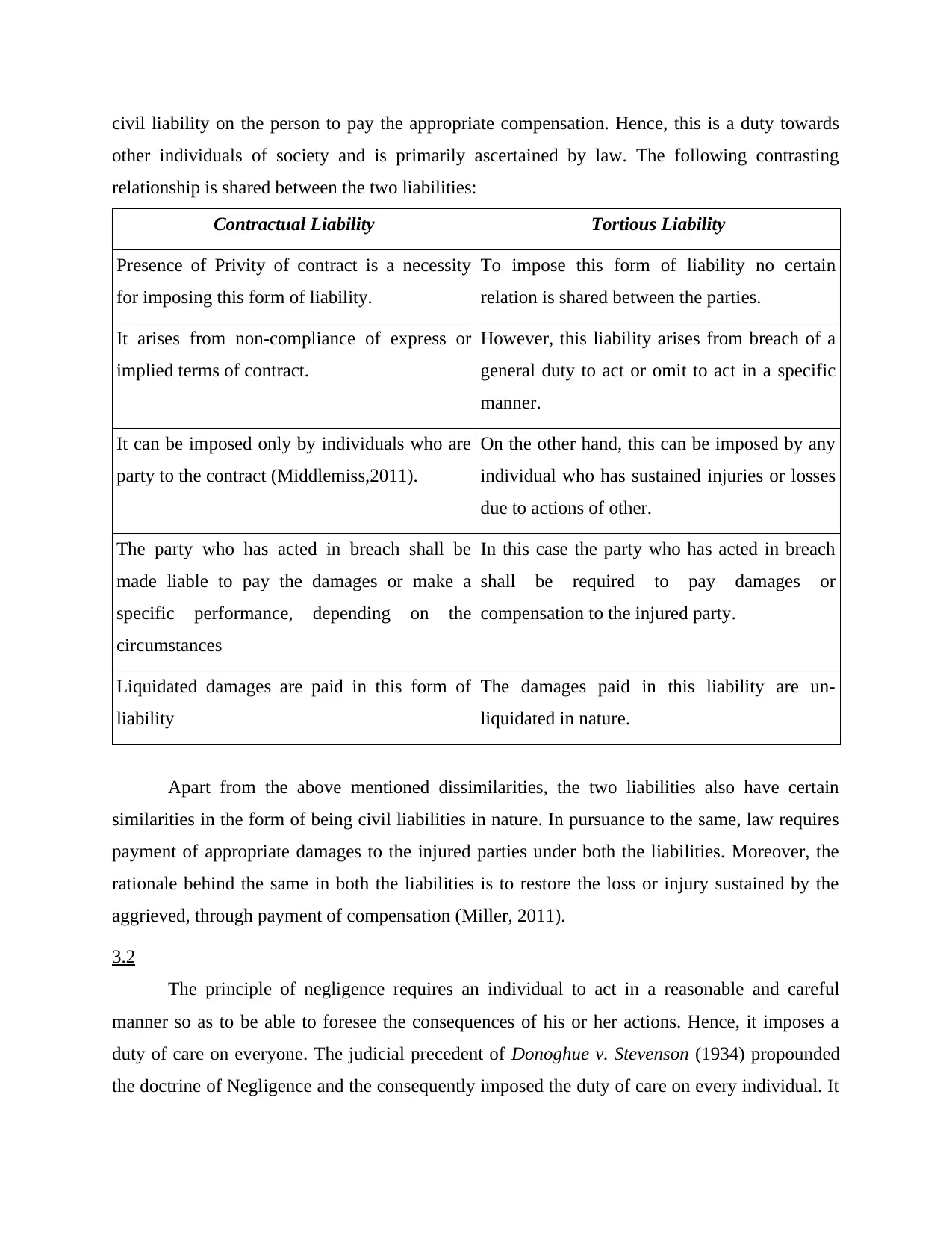
civil liability on the person to pay the appropriate compensation. Hence, this is a duty towards
other individuals of society and is primarily ascertained by law. The following contrasting
relationship is shared between the two liabilities:
Contractual Liability Tortious Liability
Presence of Privity of contract is a necessity
for imposing this form of liability.
To impose this form of liability no certain
relation is shared between the parties.
It arises from non-compliance of express or
implied terms of contract.
However, this liability arises from breach of a
general duty to act or omit to act in a specific
manner.
It can be imposed only by individuals who are
party to the contract (Middlemiss,2011).
On the other hand, this can be imposed by any
individual who has sustained injuries or losses
due to actions of other.
The party who has acted in breach shall be
made liable to pay the damages or make a
specific performance, depending on the
circumstances
In this case the party who has acted in breach
shall be required to pay damages or
compensation to the injured party.
Liquidated damages are paid in this form of
liability
The damages paid in this liability are un-
liquidated in nature.
Apart from the above mentioned dissimilarities, the two liabilities also have certain
similarities in the form of being civil liabilities in nature. In pursuance to the same, law requires
payment of appropriate damages to the injured parties under both the liabilities. Moreover, the
rationale behind the same in both the liabilities is to restore the loss or injury sustained by the
aggrieved, through payment of compensation (Miller, 2011).
3.2
The principle of negligence requires an individual to act in a reasonable and careful
manner so as to be able to foresee the consequences of his or her actions. Hence, it imposes a
duty of care on everyone. The judicial precedent of Donoghue v. Stevenson (1934) propounded
the doctrine of Negligence and the consequently imposed the duty of care on every individual. It
other individuals of society and is primarily ascertained by law. The following contrasting
relationship is shared between the two liabilities:
Contractual Liability Tortious Liability
Presence of Privity of contract is a necessity
for imposing this form of liability.
To impose this form of liability no certain
relation is shared between the parties.
It arises from non-compliance of express or
implied terms of contract.
However, this liability arises from breach of a
general duty to act or omit to act in a specific
manner.
It can be imposed only by individuals who are
party to the contract (Middlemiss,2011).
On the other hand, this can be imposed by any
individual who has sustained injuries or losses
due to actions of other.
The party who has acted in breach shall be
made liable to pay the damages or make a
specific performance, depending on the
circumstances
In this case the party who has acted in breach
shall be required to pay damages or
compensation to the injured party.
Liquidated damages are paid in this form of
liability
The damages paid in this liability are un-
liquidated in nature.
Apart from the above mentioned dissimilarities, the two liabilities also have certain
similarities in the form of being civil liabilities in nature. In pursuance to the same, law requires
payment of appropriate damages to the injured parties under both the liabilities. Moreover, the
rationale behind the same in both the liabilities is to restore the loss or injury sustained by the
aggrieved, through payment of compensation (Miller, 2011).
3.2
The principle of negligence requires an individual to act in a reasonable and careful
manner so as to be able to foresee the consequences of his or her actions. Hence, it imposes a
duty of care on everyone. The judicial precedent of Donoghue v. Stevenson (1934) propounded
the doctrine of Negligence and the consequently imposed the duty of care on every individual. It
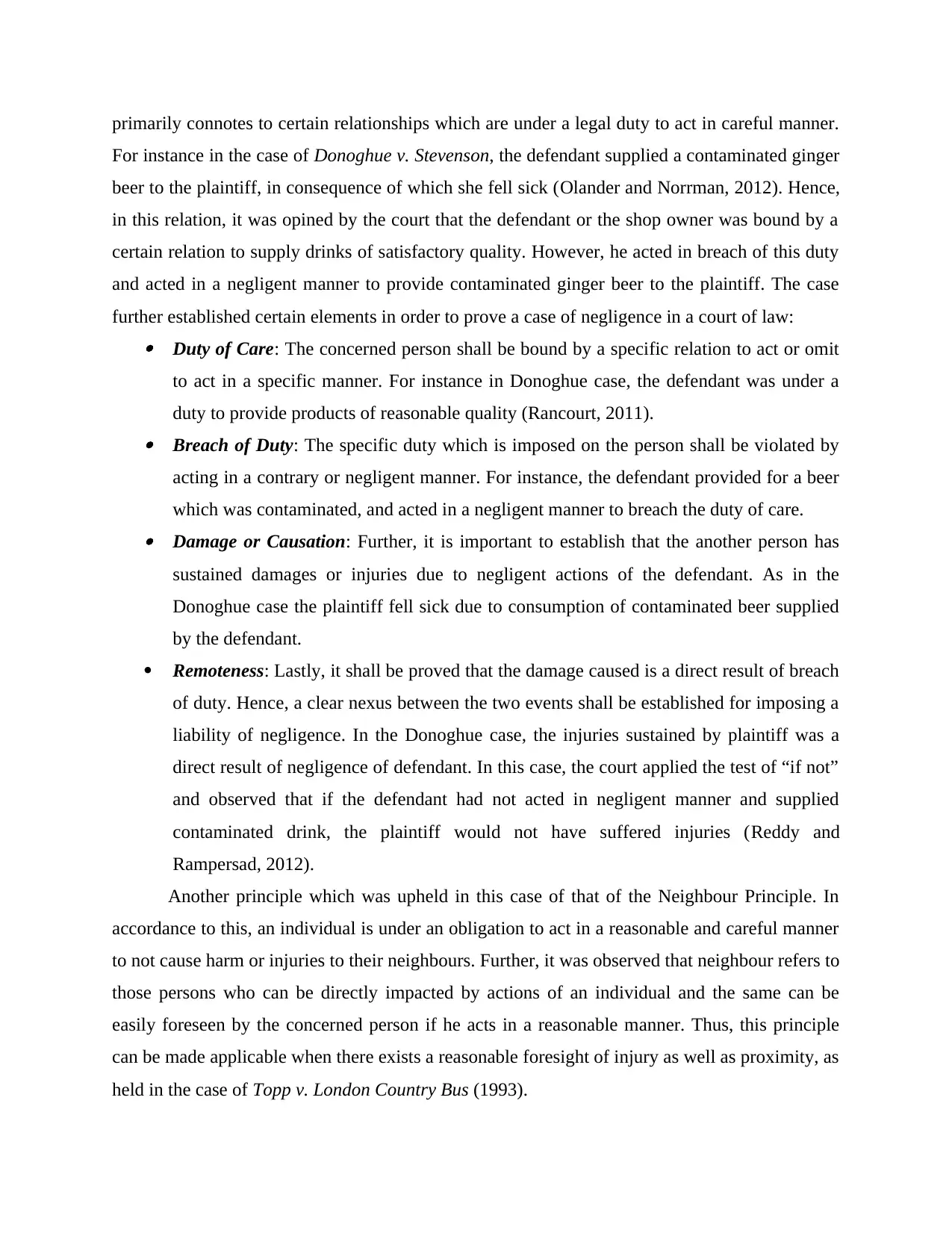
primarily connotes to certain relationships which are under a legal duty to act in careful manner.
For instance in the case of Donoghue v. Stevenson, the defendant supplied a contaminated ginger
beer to the plaintiff, in consequence of which she fell sick (Olander and Norrman, 2012). Hence,
in this relation, it was opined by the court that the defendant or the shop owner was bound by a
certain relation to supply drinks of satisfactory quality. However, he acted in breach of this duty
and acted in a negligent manner to provide contaminated ginger beer to the plaintiff. The case
further established certain elements in order to prove a case of negligence in a court of law: Duty of Care: The concerned person shall be bound by a specific relation to act or omit
to act in a specific manner. For instance in Donoghue case, the defendant was under a
duty to provide products of reasonable quality (Rancourt, 2011). Breach of Duty: The specific duty which is imposed on the person shall be violated by
acting in a contrary or negligent manner. For instance, the defendant provided for a beer
which was contaminated, and acted in a negligent manner to breach the duty of care. Damage or Causation: Further, it is important to establish that the another person has
sustained damages or injuries due to negligent actions of the defendant. As in the
Donoghue case the plaintiff fell sick due to consumption of contaminated beer supplied
by the defendant.
Remoteness: Lastly, it shall be proved that the damage caused is a direct result of breach
of duty. Hence, a clear nexus between the two events shall be established for imposing a
liability of negligence. In the Donoghue case, the injuries sustained by plaintiff was a
direct result of negligence of defendant. In this case, the court applied the test of “if not”
and observed that if the defendant had not acted in negligent manner and supplied
contaminated drink, the plaintiff would not have suffered injuries (Reddy and
Rampersad, 2012).
Another principle which was upheld in this case of that of the Neighbour Principle. In
accordance to this, an individual is under an obligation to act in a reasonable and careful manner
to not cause harm or injuries to their neighbours. Further, it was observed that neighbour refers to
those persons who can be directly impacted by actions of an individual and the same can be
easily foreseen by the concerned person if he acts in a reasonable manner. Thus, this principle
can be made applicable when there exists a reasonable foresight of injury as well as proximity, as
held in the case of Topp v. London Country Bus (1993).
For instance in the case of Donoghue v. Stevenson, the defendant supplied a contaminated ginger
beer to the plaintiff, in consequence of which she fell sick (Olander and Norrman, 2012). Hence,
in this relation, it was opined by the court that the defendant or the shop owner was bound by a
certain relation to supply drinks of satisfactory quality. However, he acted in breach of this duty
and acted in a negligent manner to provide contaminated ginger beer to the plaintiff. The case
further established certain elements in order to prove a case of negligence in a court of law: Duty of Care: The concerned person shall be bound by a specific relation to act or omit
to act in a specific manner. For instance in Donoghue case, the defendant was under a
duty to provide products of reasonable quality (Rancourt, 2011). Breach of Duty: The specific duty which is imposed on the person shall be violated by
acting in a contrary or negligent manner. For instance, the defendant provided for a beer
which was contaminated, and acted in a negligent manner to breach the duty of care. Damage or Causation: Further, it is important to establish that the another person has
sustained damages or injuries due to negligent actions of the defendant. As in the
Donoghue case the plaintiff fell sick due to consumption of contaminated beer supplied
by the defendant.
Remoteness: Lastly, it shall be proved that the damage caused is a direct result of breach
of duty. Hence, a clear nexus between the two events shall be established for imposing a
liability of negligence. In the Donoghue case, the injuries sustained by plaintiff was a
direct result of negligence of defendant. In this case, the court applied the test of “if not”
and observed that if the defendant had not acted in negligent manner and supplied
contaminated drink, the plaintiff would not have suffered injuries (Reddy and
Rampersad, 2012).
Another principle which was upheld in this case of that of the Neighbour Principle. In
accordance to this, an individual is under an obligation to act in a reasonable and careful manner
to not cause harm or injuries to their neighbours. Further, it was observed that neighbour refers to
those persons who can be directly impacted by actions of an individual and the same can be
easily foreseen by the concerned person if he acts in a reasonable manner. Thus, this principle
can be made applicable when there exists a reasonable foresight of injury as well as proximity, as
held in the case of Topp v. London Country Bus (1993).
Secure Best Marks with AI Grader
Need help grading? Try our AI Grader for instant feedback on your assignments.
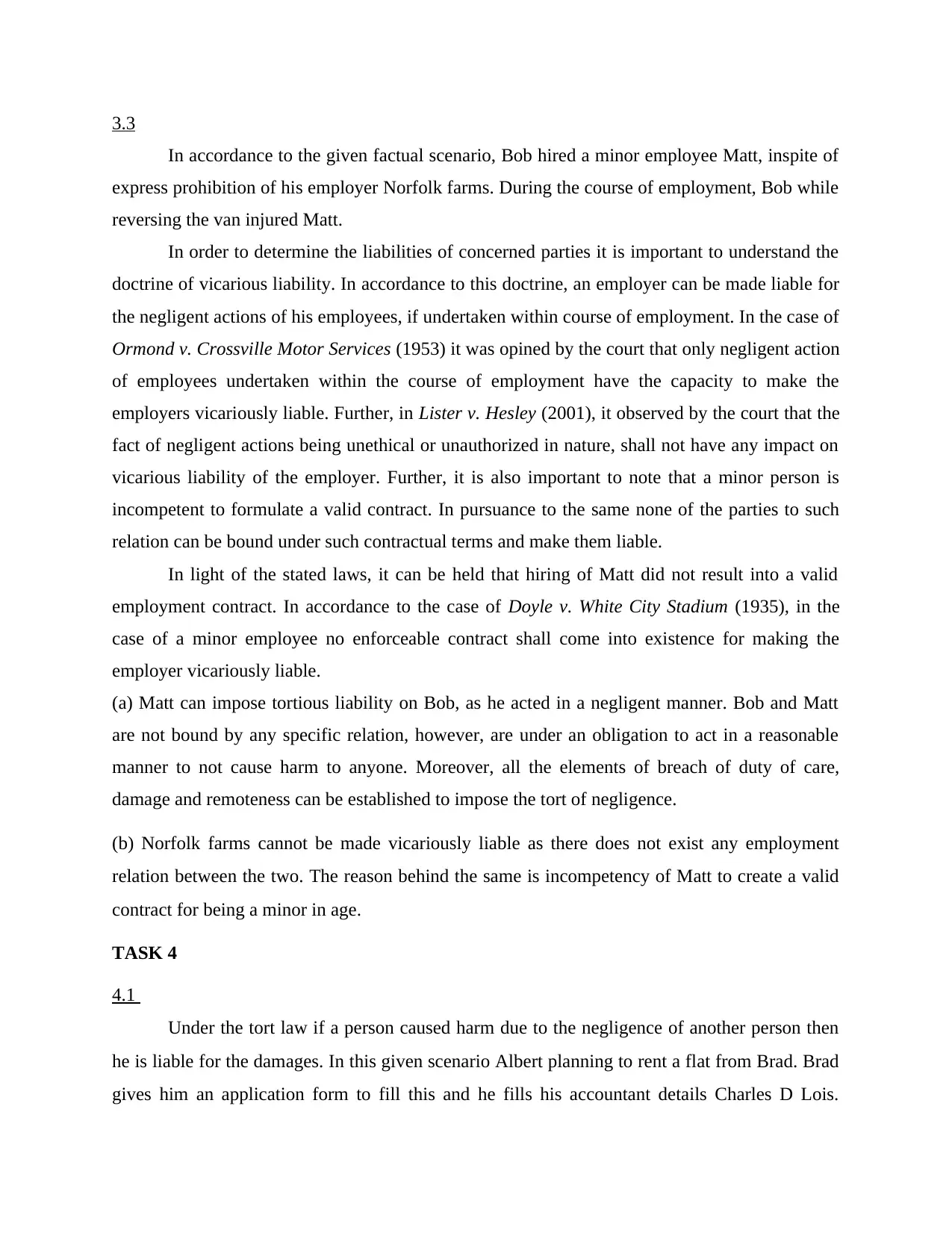
3.3
In accordance to the given factual scenario, Bob hired a minor employee Matt, inspite of
express prohibition of his employer Norfolk farms. During the course of employment, Bob while
reversing the van injured Matt.
In order to determine the liabilities of concerned parties it is important to understand the
doctrine of vicarious liability. In accordance to this doctrine, an employer can be made liable for
the negligent actions of his employees, if undertaken within course of employment. In the case of
Ormond v. Crossville Motor Services (1953) it was opined by the court that only negligent action
of employees undertaken within the course of employment have the capacity to make the
employers vicariously liable. Further, in Lister v. Hesley (2001), it observed by the court that the
fact of negligent actions being unethical or unauthorized in nature, shall not have any impact on
vicarious liability of the employer. Further, it is also important to note that a minor person is
incompetent to formulate a valid contract. In pursuance to the same none of the parties to such
relation can be bound under such contractual terms and make them liable.
In light of the stated laws, it can be held that hiring of Matt did not result into a valid
employment contract. In accordance to the case of Doyle v. White City Stadium (1935), in the
case of a minor employee no enforceable contract shall come into existence for making the
employer vicariously liable.
(a) Matt can impose tortious liability on Bob, as he acted in a negligent manner. Bob and Matt
are not bound by any specific relation, however, are under an obligation to act in a reasonable
manner to not cause harm to anyone. Moreover, all the elements of breach of duty of care,
damage and remoteness can be established to impose the tort of negligence.
(b) Norfolk farms cannot be made vicariously liable as there does not exist any employment
relation between the two. The reason behind the same is incompetency of Matt to create a valid
contract for being a minor in age.
TASK 4
4.1
Under the tort law if a person caused harm due to the negligence of another person then
he is liable for the damages. In this given scenario Albert planning to rent a flat from Brad. Brad
gives him an application form to fill this and he fills his accountant details Charles D Lois.
In accordance to the given factual scenario, Bob hired a minor employee Matt, inspite of
express prohibition of his employer Norfolk farms. During the course of employment, Bob while
reversing the van injured Matt.
In order to determine the liabilities of concerned parties it is important to understand the
doctrine of vicarious liability. In accordance to this doctrine, an employer can be made liable for
the negligent actions of his employees, if undertaken within course of employment. In the case of
Ormond v. Crossville Motor Services (1953) it was opined by the court that only negligent action
of employees undertaken within the course of employment have the capacity to make the
employers vicariously liable. Further, in Lister v. Hesley (2001), it observed by the court that the
fact of negligent actions being unethical or unauthorized in nature, shall not have any impact on
vicarious liability of the employer. Further, it is also important to note that a minor person is
incompetent to formulate a valid contract. In pursuance to the same none of the parties to such
relation can be bound under such contractual terms and make them liable.
In light of the stated laws, it can be held that hiring of Matt did not result into a valid
employment contract. In accordance to the case of Doyle v. White City Stadium (1935), in the
case of a minor employee no enforceable contract shall come into existence for making the
employer vicariously liable.
(a) Matt can impose tortious liability on Bob, as he acted in a negligent manner. Bob and Matt
are not bound by any specific relation, however, are under an obligation to act in a reasonable
manner to not cause harm to anyone. Moreover, all the elements of breach of duty of care,
damage and remoteness can be established to impose the tort of negligence.
(b) Norfolk farms cannot be made vicariously liable as there does not exist any employment
relation between the two. The reason behind the same is incompetency of Matt to create a valid
contract for being a minor in age.
TASK 4
4.1
Under the tort law if a person caused harm due to the negligence of another person then
he is liable for the damages. In this given scenario Albert planning to rent a flat from Brad. Brad
gives him an application form to fill this and he fills his accountant details Charles D Lois.
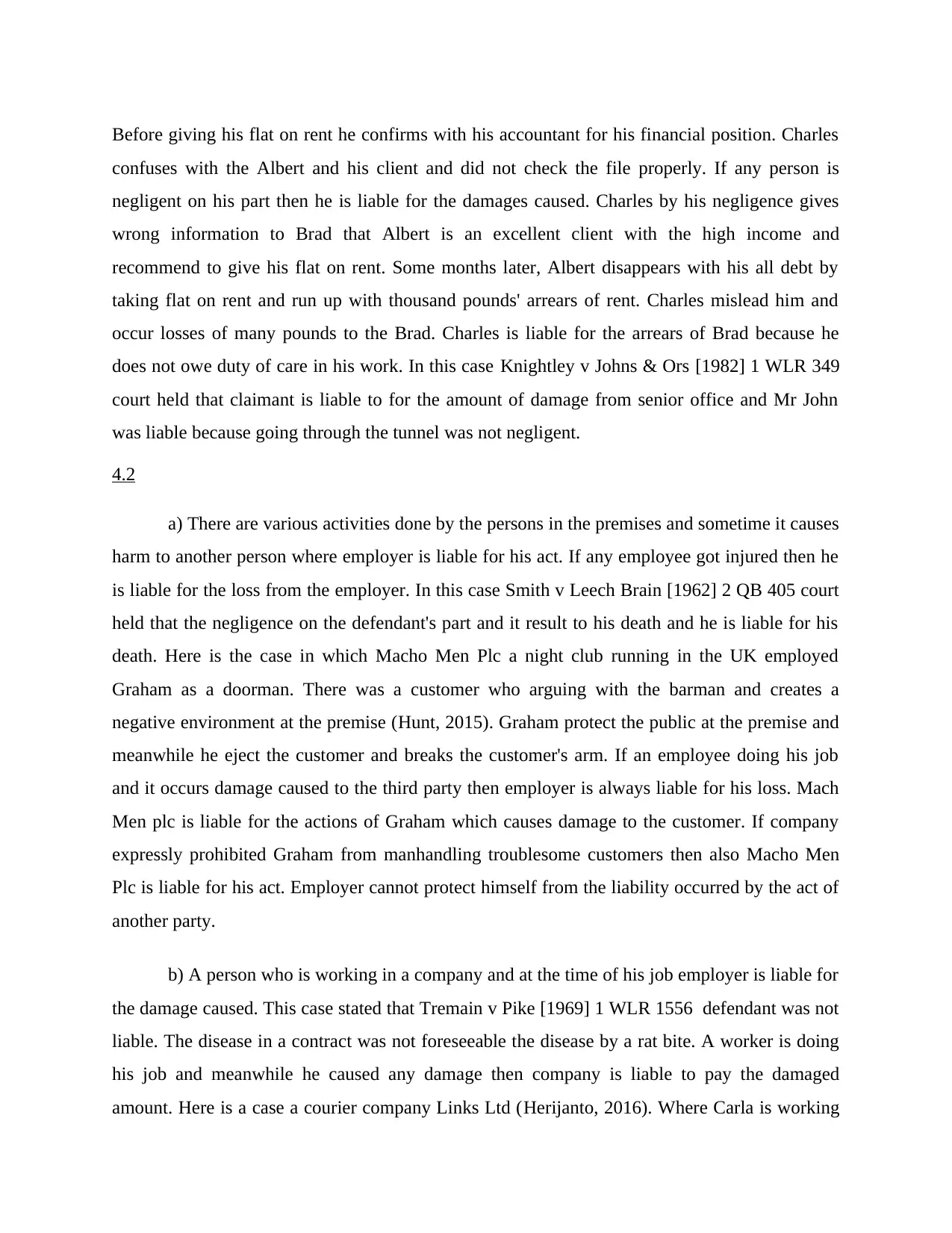
Before giving his flat on rent he confirms with his accountant for his financial position. Charles
confuses with the Albert and his client and did not check the file properly. If any person is
negligent on his part then he is liable for the damages caused. Charles by his negligence gives
wrong information to Brad that Albert is an excellent client with the high income and
recommend to give his flat on rent. Some months later, Albert disappears with his all debt by
taking flat on rent and run up with thousand pounds' arrears of rent. Charles mislead him and
occur losses of many pounds to the Brad. Charles is liable for the arrears of Brad because he
does not owe duty of care in his work. In this case Knightley v Johns & Ors [1982] 1 WLR 349
court held that claimant is liable to for the amount of damage from senior office and Mr John
was liable because going through the tunnel was not negligent.
4.2
a) There are various activities done by the persons in the premises and sometime it causes
harm to another person where employer is liable for his act. If any employee got injured then he
is liable for the loss from the employer. In this case Smith v Leech Brain [1962] 2 QB 405 court
held that the negligence on the defendant's part and it result to his death and he is liable for his
death. Here is the case in which Macho Men Plc a night club running in the UK employed
Graham as a doorman. There was a customer who arguing with the barman and creates a
negative environment at the premise (Hunt, 2015). Graham protect the public at the premise and
meanwhile he eject the customer and breaks the customer's arm. If an employee doing his job
and it occurs damage caused to the third party then employer is always liable for his loss. Mach
Men plc is liable for the actions of Graham which causes damage to the customer. If company
expressly prohibited Graham from manhandling troublesome customers then also Macho Men
Plc is liable for his act. Employer cannot protect himself from the liability occurred by the act of
another party.
b) A person who is working in a company and at the time of his job employer is liable for
the damage caused. This case stated that Tremain v Pike [1969] 1 WLR 1556 defendant was not
liable. The disease in a contract was not foreseeable the disease by a rat bite. A worker is doing
his job and meanwhile he caused any damage then company is liable to pay the damaged
amount. Here is a case a courier company Links Ltd (Herijanto, 2016). Where Carla is working
confuses with the Albert and his client and did not check the file properly. If any person is
negligent on his part then he is liable for the damages caused. Charles by his negligence gives
wrong information to Brad that Albert is an excellent client with the high income and
recommend to give his flat on rent. Some months later, Albert disappears with his all debt by
taking flat on rent and run up with thousand pounds' arrears of rent. Charles mislead him and
occur losses of many pounds to the Brad. Charles is liable for the arrears of Brad because he
does not owe duty of care in his work. In this case Knightley v Johns & Ors [1982] 1 WLR 349
court held that claimant is liable to for the amount of damage from senior office and Mr John
was liable because going through the tunnel was not negligent.
4.2
a) There are various activities done by the persons in the premises and sometime it causes
harm to another person where employer is liable for his act. If any employee got injured then he
is liable for the loss from the employer. In this case Smith v Leech Brain [1962] 2 QB 405 court
held that the negligence on the defendant's part and it result to his death and he is liable for his
death. Here is the case in which Macho Men Plc a night club running in the UK employed
Graham as a doorman. There was a customer who arguing with the barman and creates a
negative environment at the premise (Hunt, 2015). Graham protect the public at the premise and
meanwhile he eject the customer and breaks the customer's arm. If an employee doing his job
and it occurs damage caused to the third party then employer is always liable for his loss. Mach
Men plc is liable for the actions of Graham which causes damage to the customer. If company
expressly prohibited Graham from manhandling troublesome customers then also Macho Men
Plc is liable for his act. Employer cannot protect himself from the liability occurred by the act of
another party.
b) A person who is working in a company and at the time of his job employer is liable for
the damage caused. This case stated that Tremain v Pike [1969] 1 WLR 1556 defendant was not
liable. The disease in a contract was not foreseeable the disease by a rat bite. A worker is doing
his job and meanwhile he caused any damage then company is liable to pay the damaged
amount. Here is a case a courier company Links Ltd (Herijanto, 2016). Where Carla is working
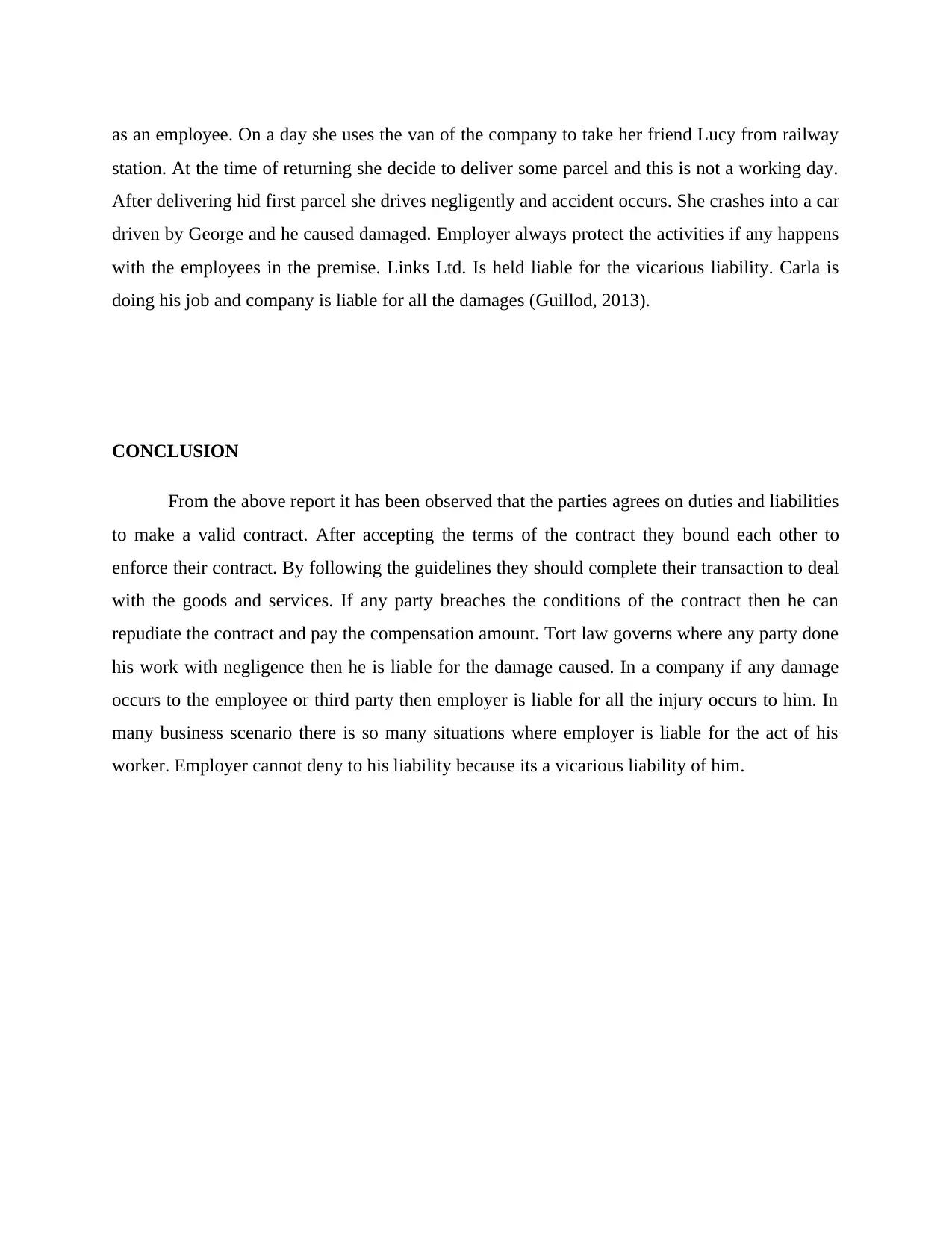
as an employee. On a day she uses the van of the company to take her friend Lucy from railway
station. At the time of returning she decide to deliver some parcel and this is not a working day.
After delivering hid first parcel she drives negligently and accident occurs. She crashes into a car
driven by George and he caused damaged. Employer always protect the activities if any happens
with the employees in the premise. Links Ltd. Is held liable for the vicarious liability. Carla is
doing his job and company is liable for all the damages (Guillod, 2013).
CONCLUSION
From the above report it has been observed that the parties agrees on duties and liabilities
to make a valid contract. After accepting the terms of the contract they bound each other to
enforce their contract. By following the guidelines they should complete their transaction to deal
with the goods and services. If any party breaches the conditions of the contract then he can
repudiate the contract and pay the compensation amount. Tort law governs where any party done
his work with negligence then he is liable for the damage caused. In a company if any damage
occurs to the employee or third party then employer is liable for all the injury occurs to him. In
many business scenario there is so many situations where employer is liable for the act of his
worker. Employer cannot deny to his liability because its a vicarious liability of him.
station. At the time of returning she decide to deliver some parcel and this is not a working day.
After delivering hid first parcel she drives negligently and accident occurs. She crashes into a car
driven by George and he caused damaged. Employer always protect the activities if any happens
with the employees in the premise. Links Ltd. Is held liable for the vicarious liability. Carla is
doing his job and company is liable for all the damages (Guillod, 2013).
CONCLUSION
From the above report it has been observed that the parties agrees on duties and liabilities
to make a valid contract. After accepting the terms of the contract they bound each other to
enforce their contract. By following the guidelines they should complete their transaction to deal
with the goods and services. If any party breaches the conditions of the contract then he can
repudiate the contract and pay the compensation amount. Tort law governs where any party done
his work with negligence then he is liable for the damage caused. In a company if any damage
occurs to the employee or third party then employer is liable for all the injury occurs to him. In
many business scenario there is so many situations where employer is liable for the act of his
worker. Employer cannot deny to his liability because its a vicarious liability of him.
Paraphrase This Document
Need a fresh take? Get an instant paraphrase of this document with our AI Paraphraser
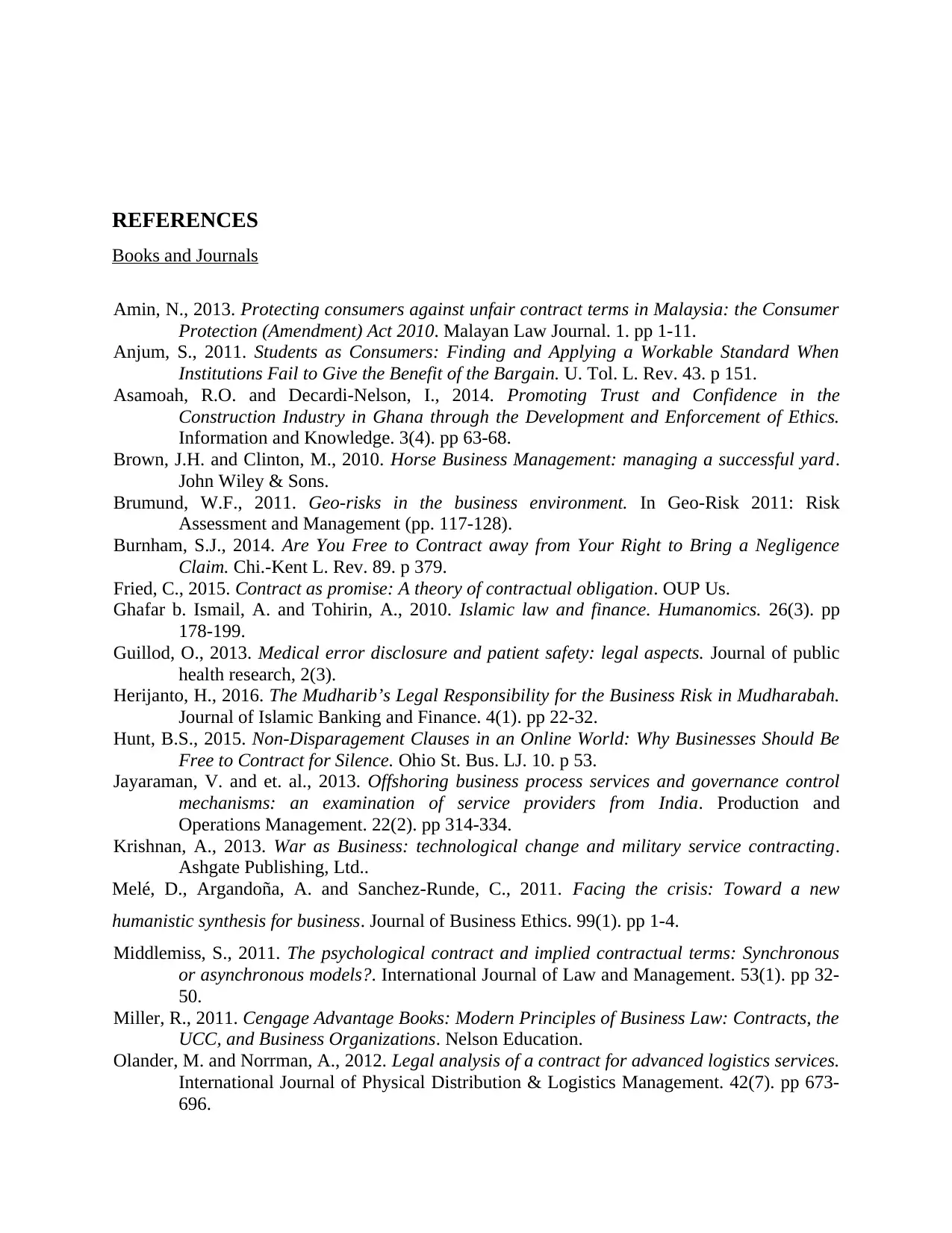
REFERENCES
Books and Journals
Amin, N., 2013. Protecting consumers against unfair contract terms in Malaysia: the Consumer
Protection (Amendment) Act 2010. Malayan Law Journal. 1. pp 1-11.
Anjum, S., 2011. Students as Consumers: Finding and Applying a Workable Standard When
Institutions Fail to Give the Benefit of the Bargain. U. Tol. L. Rev. 43. p 151.
Asamoah, R.O. and Decardi-Nelson, I., 2014. Promoting Trust and Confidence in the
Construction Industry in Ghana through the Development and Enforcement of Ethics.
Information and Knowledge. 3(4). pp 63-68.
Brown, J.H. and Clinton, M., 2010. Horse Business Management: managing a successful yard.
John Wiley & Sons.
Brumund, W.F., 2011. Geo-risks in the business environment. In Geo-Risk 2011: Risk
Assessment and Management (pp. 117-128).
Burnham, S.J., 2014. Are You Free to Contract away from Your Right to Bring a Negligence
Claim. Chi.-Kent L. Rev. 89. p 379.
Fried, C., 2015. Contract as promise: A theory of contractual obligation. OUP Us.
Ghafar b. Ismail, A. and Tohirin, A., 2010. Islamic law and finance. Humanomics. 26(3). pp
178-199.
Guillod, O., 2013. Medical error disclosure and patient safety: legal aspects. Journal of public
health research, 2(3).
Herijanto, H., 2016. The Mudharib’s Legal Responsibility for the Business Risk in Mudharabah.
Journal of Islamic Banking and Finance. 4(1). pp 22-32.
Hunt, B.S., 2015. Non-Disparagement Clauses in an Online World: Why Businesses Should Be
Free to Contract for Silence. Ohio St. Bus. LJ. 10. p 53.
Jayaraman, V. and et. al., 2013. Offshoring business process services and governance control
mechanisms: an examination of service providers from India. Production and
Operations Management. 22(2). pp 314-334.
Krishnan, A., 2013. War as Business: technological change and military service contracting.
Ashgate Publishing, Ltd..
Melé, D., Argandoña, A. and Sanchez-Runde, C., 2011. Facing the crisis: Toward a new
humanistic synthesis for business. Journal of Business Ethics. 99(1). pp 1-4.
Middlemiss, S., 2011. The psychological contract and implied contractual terms: Synchronous
or asynchronous models?. International Journal of Law and Management. 53(1). pp 32-
50.
Miller, R., 2011. Cengage Advantage Books: Modern Principles of Business Law: Contracts, the
UCC, and Business Organizations. Nelson Education.
Olander, M. and Norrman, A., 2012. Legal analysis of a contract for advanced logistics services.
International Journal of Physical Distribution & Logistics Management. 42(7). pp 673-
696.
Books and Journals
Amin, N., 2013. Protecting consumers against unfair contract terms in Malaysia: the Consumer
Protection (Amendment) Act 2010. Malayan Law Journal. 1. pp 1-11.
Anjum, S., 2011. Students as Consumers: Finding and Applying a Workable Standard When
Institutions Fail to Give the Benefit of the Bargain. U. Tol. L. Rev. 43. p 151.
Asamoah, R.O. and Decardi-Nelson, I., 2014. Promoting Trust and Confidence in the
Construction Industry in Ghana through the Development and Enforcement of Ethics.
Information and Knowledge. 3(4). pp 63-68.
Brown, J.H. and Clinton, M., 2010. Horse Business Management: managing a successful yard.
John Wiley & Sons.
Brumund, W.F., 2011. Geo-risks in the business environment. In Geo-Risk 2011: Risk
Assessment and Management (pp. 117-128).
Burnham, S.J., 2014. Are You Free to Contract away from Your Right to Bring a Negligence
Claim. Chi.-Kent L. Rev. 89. p 379.
Fried, C., 2015. Contract as promise: A theory of contractual obligation. OUP Us.
Ghafar b. Ismail, A. and Tohirin, A., 2010. Islamic law and finance. Humanomics. 26(3). pp
178-199.
Guillod, O., 2013. Medical error disclosure and patient safety: legal aspects. Journal of public
health research, 2(3).
Herijanto, H., 2016. The Mudharib’s Legal Responsibility for the Business Risk in Mudharabah.
Journal of Islamic Banking and Finance. 4(1). pp 22-32.
Hunt, B.S., 2015. Non-Disparagement Clauses in an Online World: Why Businesses Should Be
Free to Contract for Silence. Ohio St. Bus. LJ. 10. p 53.
Jayaraman, V. and et. al., 2013. Offshoring business process services and governance control
mechanisms: an examination of service providers from India. Production and
Operations Management. 22(2). pp 314-334.
Krishnan, A., 2013. War as Business: technological change and military service contracting.
Ashgate Publishing, Ltd..
Melé, D., Argandoña, A. and Sanchez-Runde, C., 2011. Facing the crisis: Toward a new
humanistic synthesis for business. Journal of Business Ethics. 99(1). pp 1-4.
Middlemiss, S., 2011. The psychological contract and implied contractual terms: Synchronous
or asynchronous models?. International Journal of Law and Management. 53(1). pp 32-
50.
Miller, R., 2011. Cengage Advantage Books: Modern Principles of Business Law: Contracts, the
UCC, and Business Organizations. Nelson Education.
Olander, M. and Norrman, A., 2012. Legal analysis of a contract for advanced logistics services.
International Journal of Physical Distribution & Logistics Management. 42(7). pp 673-
696.
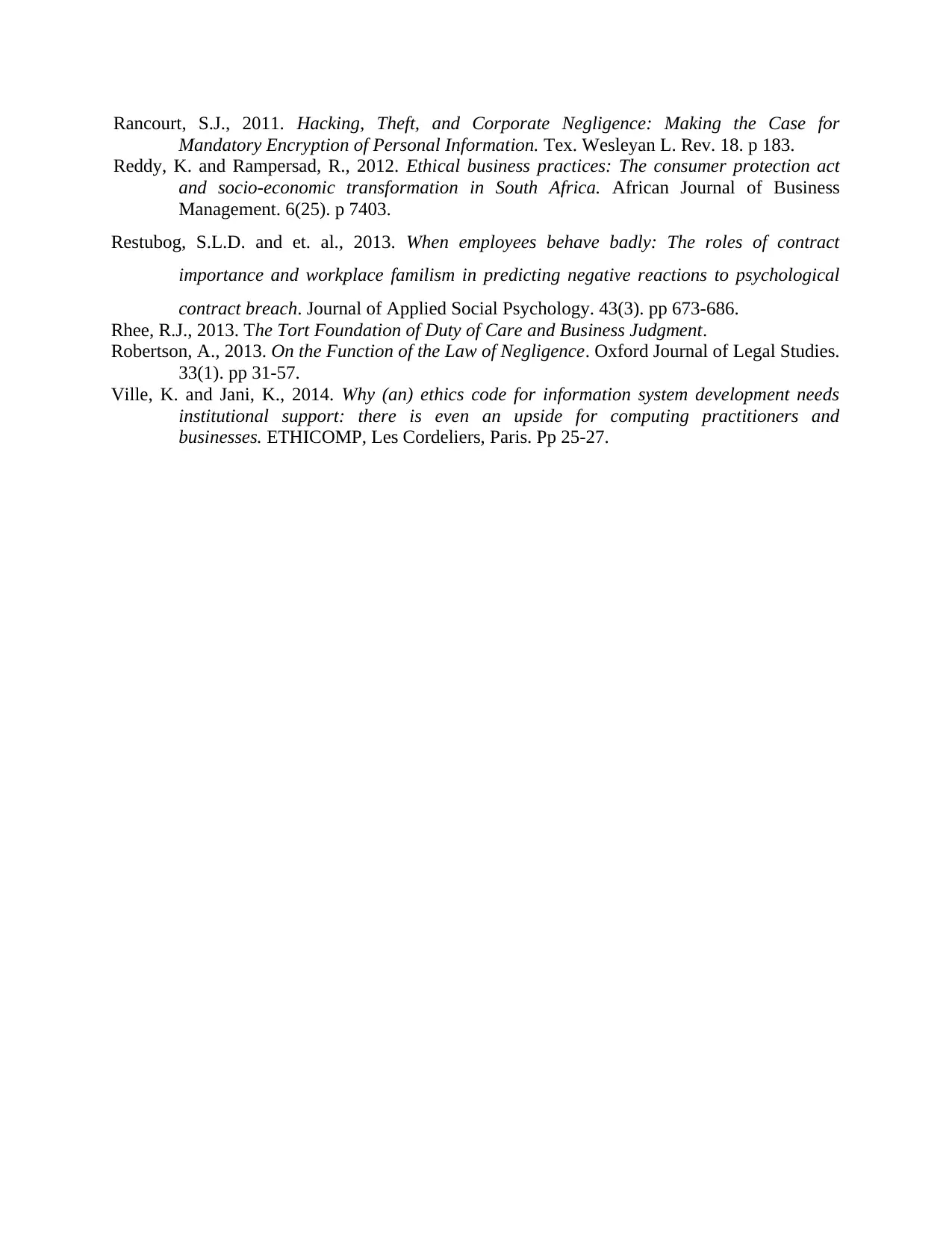
Rancourt, S.J., 2011. Hacking, Theft, and Corporate Negligence: Making the Case for
Mandatory Encryption of Personal Information. Tex. Wesleyan L. Rev. 18. p 183.
Reddy, K. and Rampersad, R., 2012. Ethical business practices: The consumer protection act
and socio-economic transformation in South Africa. African Journal of Business
Management. 6(25). p 7403.
Restubog, S.L.D. and et. al., 2013. When employees behave badly: The roles of contract
importance and workplace familism in predicting negative reactions to psychological
contract breach. Journal of Applied Social Psychology. 43(3). pp 673-686.
Rhee, R.J., 2013. The Tort Foundation of Duty of Care and Business Judgment.
Robertson, A., 2013. On the Function of the Law of Negligence. Oxford Journal of Legal Studies.
33(1). pp 31-57.
Ville, K. and Jani, K., 2014. Why (an) ethics code for information system development needs
institutional support: there is even an upside for computing practitioners and
businesses. ETHICOMP, Les Cordeliers, Paris. Pp 25-27.
Mandatory Encryption of Personal Information. Tex. Wesleyan L. Rev. 18. p 183.
Reddy, K. and Rampersad, R., 2012. Ethical business practices: The consumer protection act
and socio-economic transformation in South Africa. African Journal of Business
Management. 6(25). p 7403.
Restubog, S.L.D. and et. al., 2013. When employees behave badly: The roles of contract
importance and workplace familism in predicting negative reactions to psychological
contract breach. Journal of Applied Social Psychology. 43(3). pp 673-686.
Rhee, R.J., 2013. The Tort Foundation of Duty of Care and Business Judgment.
Robertson, A., 2013. On the Function of the Law of Negligence. Oxford Journal of Legal Studies.
33(1). pp 31-57.
Ville, K. and Jani, K., 2014. Why (an) ethics code for information system development needs
institutional support: there is even an upside for computing practitioners and
businesses. ETHICOMP, Les Cordeliers, Paris. Pp 25-27.
1 out of 15
Related Documents
Your All-in-One AI-Powered Toolkit for Academic Success.
+13062052269
info@desklib.com
Available 24*7 on WhatsApp / Email
![[object Object]](/_next/static/media/star-bottom.7253800d.svg)
Unlock your academic potential
© 2024 | Zucol Services PVT LTD | All rights reserved.





